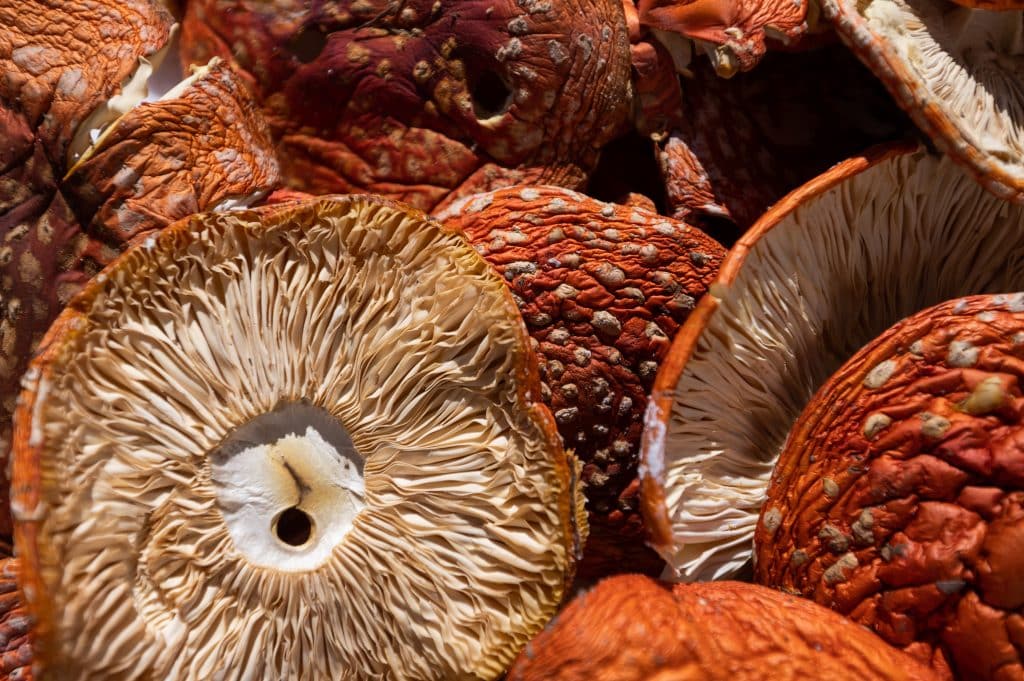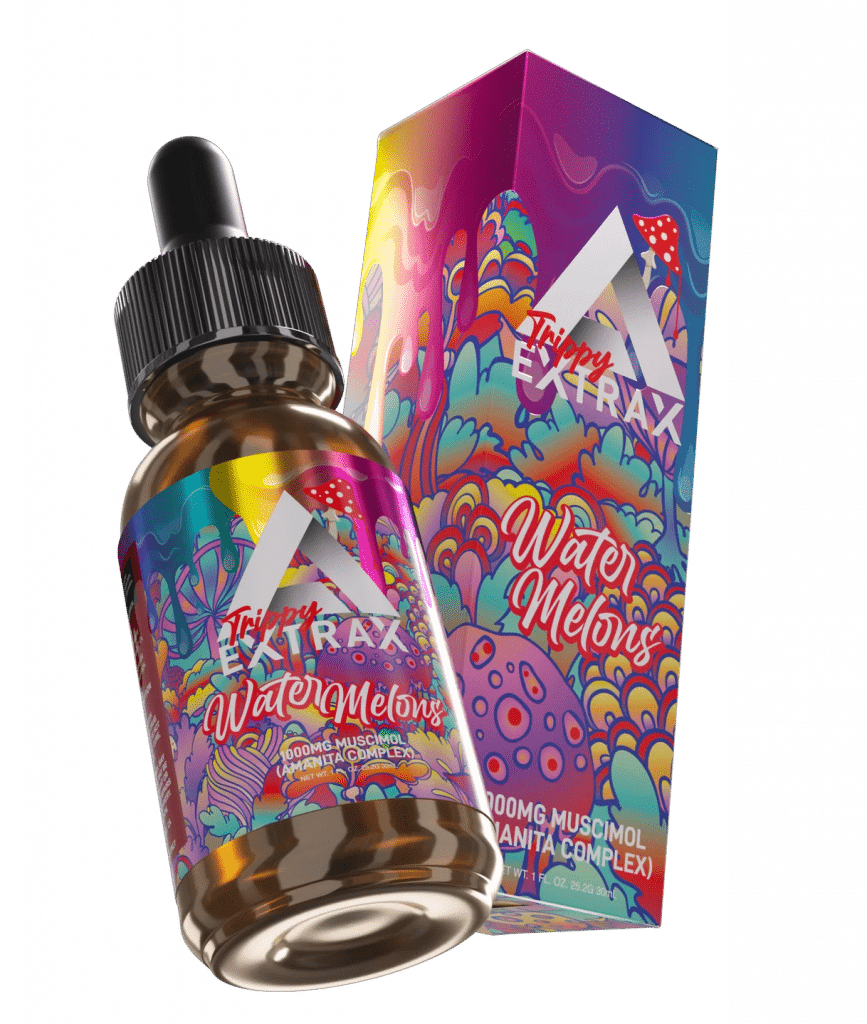
Muscimol is a naturally occurring psychoactive compound with a history as rich and diverse as the mushrooms from which it is derived. Most notably found in the Amanita muscaria, commonly known as the fly agaric or fly amanita, muscimol is responsible for the characteristic psychoactive effects associated with this iconic red-and-white mushroom. When ingested, muscimol effects can vary greatly, from sedation and muscle relaxation to euphoria and hallucinations.
It is important to note that recent attention on muscimol has been driven by a resurgence of interest in the Amanita species, particularly in the United States. This renewed interest has resulted in the emergence of various muscimol products, including Muscimol gummies, Muscimol isolate, tinctures, Amanita powder, Amanita chocolates and many alternative forms of muscimol consumption.
It’s important to approach new muscimol products with caution due to potential variations in safety, quality, and legality. While they offer alternative forms of consumption and exciting possibilities for exploration, it is crucial to prioritize safety and responsibility when considering these products.
Muscimol Effects Revealed: Exploring the Potential Uses of the Psychoactive Compound
Chemistry and Mechanism of Action of Muscimol
Muscimol is an isoxazole, a class of organic compounds characterized by a five-membered heterocyclic ring structure. Its chemical structure is similar to that of the neurotransmitter gamma-aminobutyric acid (GABA), allowing it to bind with high affinity to the GABA A receptors in the brain.
The GABA A receptors are the primary inhibitory receptors in the brain, meaning they reduce neuronal excitability. When muscimol binds to these receptors, it mimics the action of GABA, leading to increased inhibition of neuronal activity. This action is not uniform across the brain but rather varies depending on the region. For instance, in the hippocampus, a region involved in learning and memory, muscimol can lead to amnesic effects, while in other areas, it might induce sedative or hallucinogenic effects.
Muscimol in Nature
Muscimol is primarily found in the mushrooms of the Amanita genus, most notably the Amanita muscaria and Amanita pantherina. These species are widespread across the Northern Hemisphere, spanning North America, Europe, and Asia. They typically grow in symbiosis with various tree species in forested environments which makes growing them in a lab a very complicated problem.
(Image credit: Amanita Mushrooms)
Within the mushroom, the concentration of muscimol varies, typically with higher levels found in the mushroom cap compared to the stem. It’s important to note that muscimol is not the sole psychoactive compound present in these mushrooms. Another compound known as ibotenic acid acts as a prodrug to muscimol, meaning it is metabolized into muscimol in the body, contributing to the overall psychoactive effect.
However, it is worth mentioning that ibotenic acid can have undesirable side effects. To mitigate these effects, it is recommended to properly prepare the mushrooms before consumption. This involves drying and heating them to convert the ibotenic acid into muscimol, thereby enhancing the desired psychoactive properties while minimizing potential adverse reactions.
Muscimol Effects
Understanding the effects of Muscimol can be complex as they vary between individuals. Additionally, these effects are dose-dependent, ranging from mild sedative and hypnotic effects at lower doses to more intense hallucinations and delirium at higher doses. Due to the variability in potency among individual mushrooms and even within different parts of the same mushroom, determining an accurate dose can be quite challenging.
It is important to note that the effects of muscimol can be unpredictable and vary from person to person. Here is an overview of muscimol’s effects and dosage considerations.
Effects of Muscimol:
- Sedation and Muscle Relaxation: Muscimol has been reported to induce a sedative effect, leading to relaxation and a sense of calmness.
- Euphoria: Some individuals may experience a state of euphoria, characterized by feelings of happiness and well-being.
- Hallucinations: Higher doses of muscimol can lead to hallucinations, including visual distortions and vivid sensory experiences.
- Altered Perception: Muscimol can alter perception and enhance sensory experiences, resulting in a different perception of reality.
- Amnesic Effects: In certain brain regions, such as the hippocampus involved in learning and memory, muscimol may induce amnesic effects.

Dosage of Muscimol: Determining an accurate dosage of muscimol can be challenging due to variations in potency among different mushrooms and even within different parts of the same mushroom. It is crucial to approach muscimol dosage with caution and start with lower doses to assess individual sensitivity.
As always, follow the golden rule of Start Low and Grow Slow, and if possible, consider microdosing first.
Here are some general dosage considerations:
- Threshold Dose: The threshold dose of muscimol, where subtle effects may be noticeable, is reported to be around 5-10 milligrams (mg).
- Mild to Moderate Effects: To experience mild to moderate effects, a dosage range of 10-15 mg of muscimol is often suggested.
- Higher Doses: Higher doses of muscimol, typically above 15 mg, can potentially lead to more intense hallucinatory experiences. However, these doses also come with an increased risk of side effects and a more profound impact on consciousness.
It is important to remember that individual reactions to muscimol can vary significantly, and responsible use is essential. Due to the risks and potential uncertainties associated with consuming wild mushrooms, it is recommended to approach muscimol use with caution and consider consulting with experts or mycologists for guidance on safe and appropriate dosages.
Potential Therapeutic Uses of Muscimol
Here are some of the potential therapeutic uses of muscimol:
- Anti-epileptic
- Anxiolytic
- Muscle relaxant
- Promoter of restorative sleep
Muscimol is a GABA A receptor agonist, which means it binds to and activates these receptors. GABA A receptors are involved in a variety of functions, including sleep, anxiety, and movement. Muscimol has been shown to have anti-epileptic, anxiolytic, and muscle relaxant effects in animal studies. There have been a few small clinical trials of muscimol in humans, but more research is needed to confirm these findings and to determine the therapeutic uses, optimal dose and even safety of muscimol for human use…
So for now, we can only say that the above are potential benefits. We will continue to monitor the advance of research and let know once we learn more.
The Historical and Cultural Context of Muscimol Use
The use of Amanita muscaria as an entheogen, a substance used for spiritual or ritualistic purposes, dates back centuries, if not millennia. Its use is particularly notable in Siberian shamanic traditions, where the mushroom was consumed in religious ceremonies. The shamanic rituals involving Amanita muscaria were believed to facilitate communication with spirits and induce altered states of consciousness. Remarkably, due to the unique excretion pattern of muscimol, the urine of individuals who had consumed the mushroom was also ingested, as it still contained significant amounts of the active compound. This practice demonstrates the cultural significance and reverence attributed to muscimol and the mushrooms that contain it.
Beyond these traditional uses, Amanita muscaria and its active compound muscimol have held a captivating place in popular culture, symbolizing the psychedelic experience and playing a role in various folklore and fairy tales. The distinct appearance of the red-and-white fly agaric mushroom has made it an enduring symbol in art, literature, and mythology, further solidifying its cultural significance.

Safety Considerations and Potential Risks
While muscimol’s effects may intrigue some, it is crucial to emphasize the potential risks and safety considerations associated with its use. Side effects can include nausea, sweating, decreased motor coordination, and in severe cases, loss of consciousness. Moreover, given the high variability in potency between individual mushrooms and the potential presence of other compounds, such as ibotenic acid, there is a significant risk of accidental overdose.
Additionally, Amanita mushrooms can contain compounds that are toxic in high doses. Ibotenic acid, for example, can lead to neurotoxic effects when consumed in excessive amounts. Therefore, consuming these mushrooms, even for the purpose of experiencing the effects of muscimol, poses substantial risks. It is essential to exercise caution, educate oneself about mushroom identification and safety measures, and consider consulting with experts or mycologists before attempting to consume wild mushrooms.
One tip you should always follow is that Amanita mushrooms should be carefully dried and heated so that most of the Ibotenic acid will be converted into Muscimol. While you can eat raw mushrooms, and many do, too much Ibotenic acid will make you feel very bad, so stick with the dried powder if you are only taking your first steps with these mushrooms.
Legality and Regulation of Muscimol
The legal status of muscimol varies considerably across countries and states. In some jurisdictions, it is considered a controlled substance, while in others, it is legal to possess and consume. However, even where it is legal, the sale of Amanita mushrooms may be regulated in some countries due to their potential for misuse and the health risks associated with their consumption. It is important for anyone considering the use of muscimol to familiarize themselves with the local laws and regulations pertaining to this substance.
Generally speaking, in the US, most states allow the use of Amanita mushrooms as they are not a scheduled product.
Muscimol Effects – Conclusion
The effects of muscimol are a fascinating subject of exploration. From its sedative and hypnotic properties to the potential for hallucinations and altered reality, muscimol offers a diverse range of experiences. The dose-dependent nature of muscimol further adds to its complexity, requiring caution and responsible use.
Understanding muscimol and its interaction with the GABA A receptors provides valuable insights into the complexities of brain chemistry and the potential for novel therapeutic interventions. As our knowledge of muscimol continues to evolve, further research and scientific investigation will shed light on its full potential and expand our understanding of its effects and applications.
Keep Yourself Informed With Our Weekly Newsletter
Introducing the Cannadelics Sunday Edition, your ultimate weekly newsletter delivering the best stories from the world of cannabis and psychedelics. Stay up to date with the latest trends, groundbreaking research, and insightful articles carefully curated just for you. But that’s not all! As a subscriber, you’ll gain access to exclusive discounts on legal cannabis and psychedelic products, making your journey even more enlightening and affordable.
Join the Cannadelics community today and elevate your Sundays with knowledge, discounts, and a vibrant community of like-minded individuals passionate about the transformative power of cannabis and psychedelics.
Simply put your email below:






